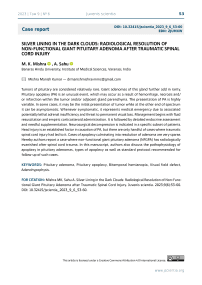Silver lining in the dark clouds: radiological resolution of non-functional giant pituitary adenoma after traumatic spinal cord injury
Автор: Mishra M.K., Sahu A.
Журнал: Juvenis scientia @jscientia
Рубрика: Клинические случаи
Статья в выпуске: 6 т.9, 2023 года.
Бесплатный доступ
Tumors of pituitary are considered relatively rare. Giant adenomas of this gland further add in rarity. Pituitary apoplexy (PA) is an unusual event, which may occur as a result of hemorrhage, necrosis and/or infarction within the tumor and/or adjacent gland parenchyma. The presentation of PA is highly variable. In some cases, it may be the initial presentation of tumor while at the other end of spectrum it can be asymptomatic. Whenever symptomatic, it represents medical emergency due to associated potentially lethal adrenal insufficiency and threat to permanent visual loss. Management begins with fluid resuscitation and empiric corticosteroid administration. It is followed by detailed endocrine assessment and needful supplementation. Neurosurgical decompression is indicated in a specific subset of patients. Head injury is an established factor in causation of PA, but there are only handful of cases where traumatic spinal cord injury had led to it. Cases of apoplexy culminating into resolution of adenoma are very sparse. Hereby authors report a case where non-functional giant pituitary adenoma (NFGPA) has radiologically evanished after spinal cord trauma. In this manuscript, authors also discuss the pathophysiology of apoplexy in pituitary adenomas, types of apoplexy as well as standard protocol recommended for follow-up of such cases.
Pituitary adenoma, pituitary apoplexy, bitemporal hemianopia, visual field defect, adenohypophysis
Короткий адрес: https://sciup.org/14129119
IDR: 14129119 | DOI: 10.32415/jscientia_2023_9_6_53-60
Текст научной статьи Silver lining in the dark clouds: radiological resolution of non-functional giant pituitary adenoma after traumatic spinal cord injury
Tumors of the “master endocrine gland” are considered relatively rare, mostly asymptomatic and incidental on imaging. However, their prevalence extrapolated from pooled data of autopsy series / radiological tests ranges from 14.4% to 22.5% [1]. Pituitary apoplexy (PA) is an uncommon event with an incidence of 4%-20% in patients with adenomas [2]. The symptomatology of PA may span from a subclinical course to headache, blindness, coma and death. Head injury, surgery, pregnancy, use of certain drugs, pathological coagulation states etc. are established precipitating factors of PA. Herуby authors report an extremely unusual case where a giant pituitary adenoma evanesced radiologically, following traumatic spinal cord injury and apoplectic event.
CASE REPORT
A 40 years old farmer presented to institute’s neurosurgery outpatient department (OPD) with complaints of progressive restriction of visual field in both eyes for 2 years. He had no comorbidities. There was bitemporal hemianopia on perimetry (Figure: 1).
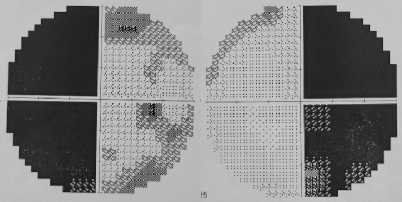
Figure 1: Visual field of the patient on Humphrey visual field analyzer (HFA) using 30–2 SITA Fast standard strategy with reliable indices (fixation loss < 20%, false positive/negative <30%) showing bitemporal hemianopia.
Magnetic resonance imaging (MRI) brain showed 5.2×4.6×3.8 cm well-defined lobulated mass lesion at sella turcica with supra-sellar extension. It was iso to hypo-intense at T1 and iso to hyper-intense at T2 sequence. Tumor had moderate diffuse enhancement on administration of contrast. It was involving cavernous sinus and internal carotid artery on either sides of sella (Figure: 2a).

Optic chiasm and floor of third ventricle were pushed superiorly by the tumor (Figure: 2b).
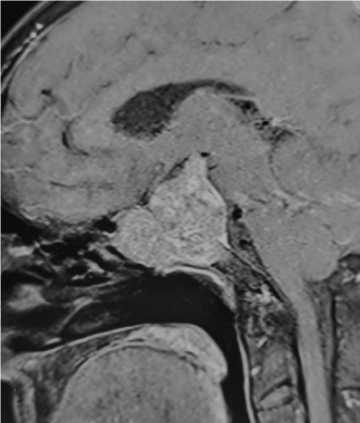
Figure 2b: Sagittal section of CEMRI brain showing the supra-sellar extension of giant pituitary adenoma displacing optic chiasm and IIIrd ventricle.
Pulse sequence on magnetic resonance spectroscopy (MRS) had increased choline peak, suggestive of neoplastic pathology (Figure: 2c).
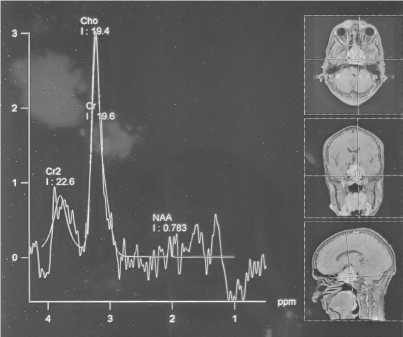
Figure 2c: Magnetic resonance spectroscopy (MRS) showing decreased N-acetyl aspartate (NAA) signals and elevated choline peak.
Hormone profile (thyroid stimulating hormone, serum adrenocorticotropic hormone, serum cortisol, serum growth hormone, serum prolactin, serum testosterone) was within normal limits. Diagnosis of “non-functional giant pituitary adenoma (NFGPA)” was established.
In course of pre-operative planning and decision making for surgical resection of tumor, the patient was hit by his pet at his countryside farm. Due to visual field defect, he couldn’t notice the approaching
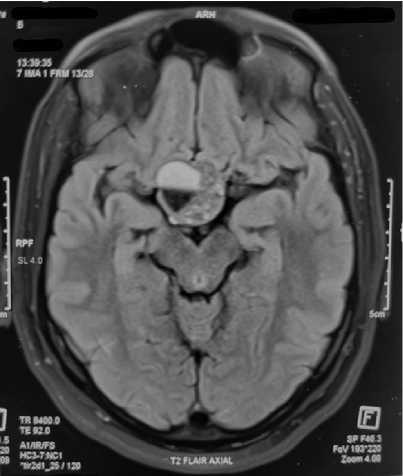
Figure 3b: FLAIR (fluid attenuated inversion recovery) sequence axial section of MRI brain showing T2-weighted heterointense sellar-suprasellar lesion with area of cystic degeneration in the right lateral aspect. Cystic component of the lesion is showing blood-fluid level. Overall features are suggestive of hemorrhage (late subacute stage of hematoma) within the giant pituitary adenoma.
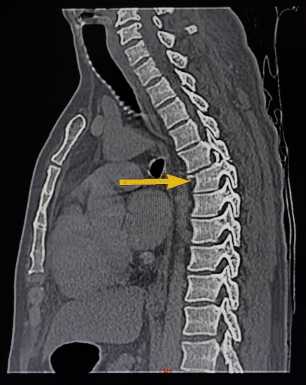
Figure 3a: CT spine (sagittal section) showing anterior wedge fracture (yellow arrow) of 6th thoracic vertebra.
nanny goat. Secondary to the impact sustained over knee/thigh, the patient fell onto the buttocks, developed backache and was unable to move his both lower limbs. There was no direct blow to the patient’s head. He was admitted at a local health centre in view of flaccid paraplegia. Radiographs showed D6 vertebral fracture (Figure: 3a) and associated spinal cord contusion.
Supportive treatment for spinal cord injury (SCI) was instituted. On 2nd day of SCI, the patient noticed headache in between the weaning-off phases of analgesic. However, it didn’t become his leading symptom until he was discharged. On 10th day of trauma, the patient was brought to us with progressive headache, not responding to the prescribed dose of oral painkillers. His consciousness on Glasgow coma scale was E4V5M6. There was right sided IIIrd cranial nerve palsy. Motor power was 0/5 in all myotomes of both lower
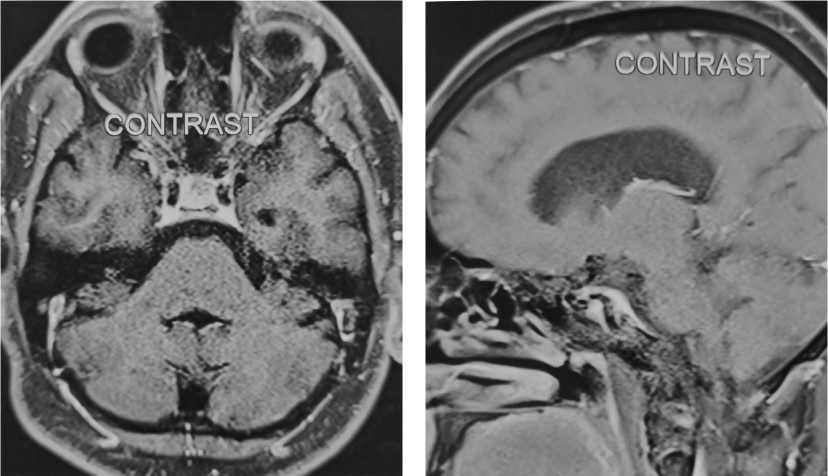
Figure 4a: Axial section of CEMRI brain showing normally enhancing pituitary gland.
extremities, corresponding reflexes were absent and there was loss of anal tone. Brain imaging revealed areas of hemorrhage within pituitary adenoma (Figure: 3b).
Corticosteroid supplementation was started with other empiric treatment. His GCS didn’t deteriorate during convalescence and he was discharged on medications. At 3 months’ follow-up, flaccid paraplegia was taken over by spastic paraparesis (power in both lower limbs: 3/5 on MRC scale). Ophthalmoplegia was resolved. There was no worsening of visual field (assessed by “confrontation method”, as perimetry was not feasible due to limb spasticity). CEMRI brain with screening of spine was repeated. Surprisingly pituitary appeared normal in morphology and signal intensity with normal homogenous enhancement (Figure: 4a, 4b).
Spinal insults were also seen resolving. At D6 vertebral level there was mild kyphosis and the cord had myelomalacic changes (Figure: 4c).
With an advice of limb physiotherapy, the patient was asked to visit us every 3 months or, prior “if needed”. At 1-year follow-up, there was no recurrence of adenoma, and hormonal assays were normal.
Figure 4b: Sagittal section of CEMRI brain. Pituitary is appearing normal in intensity as well as in morphology.
DISCUSSION
Tumors of pituitary are called “adenomas”, and they grow from adenohypophysis (anterior pituitary). On the basis of size, they can be microadenomas (<1 cm), macroadenomas (>1 cm), or giant adenomas (>4 cm). Endocrinologically they are classified as functional/secretary, or non-functional/non-secretary tumors. Patients become symptomatic either due to the mass effect (macroadenomas / giant adenomas), or secondary to the hormonal imbalance (functional adenomas). Nonfunctional microadenomas remain occult clinically. They are detected incidentally on CT / MRI of the head [1]. Contrast (Gadolinium) enhanced magnetic resonance imaging (CEMRI) of brain coupled with biochemical assessment of various hormones (prolactin, growth hormone, adrenocorticotropic hormone, thyroid stimulating hormone, free T4, follicle stimulating hormone, estradiol, testosterone, fasting early morning cortisol) is mandatory for establishment of diagnosis. Treatment (observation / medical management using dopamine agonists / transsphenoidal resection) is tailored in accordance

Figure 4c: T2-weighted screening MRI of whole spine (sagittal section) showing anterior wedge compression of D6 vertebra (red arrow) with focal myelomalacia of the cord (black arrow).
with symptoms, size and functional status of a tumor.
There can be hemorrhage/infarction within pituitary, or adenoma (more common) leading to apoplexy. PA is an infrequent event with an incidence of 4–20% of cases with pituitary tumors [2]. Non-func-tional macroadenomas, prolactinomas and growth hormone secreting tumors are more prone to apoplexy in the corresponding order. Nevertheless, PA in giant pituitary adenomas is extremely rare [3, 4]. Apoplexy can be asymptomatic or may manifest with spectrum of symptoms like headache, visual disturbance, blindness, cranial nerve palsy, endocrine dysfunctions, altered sensorium, coma and death. Sub-clinical PA is found in 10–25% cases and gets detected on imaging (CT / MRI brain) or on histopathological examination of the resected tumor [2, 3].
Pituitary is a highly vascular endocrine gland and receives its blood supply from superior/inferior hypophyseal arteries as well as from portal system. Portal vasculature is a low pressure system, thus intrinsically sensitive to volume and pressure changes in systemic circulation. Adenohypophysis has no direct arterial supply. It is fed exclusively by portal system. Conversely the posterior pituitary gland gets its supply through inferior hypophyseal artery, which functions under higher pressure. This peculiarity renders anterior pituitary prone to vascular insults [2, 3].
Adenomas, in comparison to the gland, have higher metabolism, sparse blood supply and immature-fragile vessels. Whenever this metabolic rate outgrows the blood supply, PA precipitates. Additionally, compression on feeding vessels at sellar diaphragm by expanding tumor, has also been postulated to cause apoplexy [3].
Post-PA adenomas may show recurrence. The rate of recurrence is higher in patients who are managed conservatively (22%) when compared to patients treated surgically (4%) [5]. In a long term follow-up study, there was 11% risk of tumor recurrence post apoplexy, when patients were followed up for a mean duration of 81 months [6]. UK guidelines for PA recommends CEMRI brain at 3–6 months after PA, annually for five years, and once in two years thereafter [2].
There are various factors which trigger PA either by stressing the gland (e. g. myocardial infarction, surgery, anticoagulant drugs) or by bringing fluctu- ations in blood pressure. Historically, Van Wagenen has reported the first two cases of post-traumatic pituitary apoplexy in 1932 [7]. D. Billeci et al. (2017) in their article highlighted the rarity of post-traumatic PA in adenomas. There were only thirteen patients with pituitary adenoma, including their case, which developed apoplexy. All patients had sustained varying degrees of head injury [7]. There have been few citations of pituitary apoplexy following lumbar fusion surgery and spinal anaesthesia [8, 9].
Probably this is the first case in literature, where there is complete radiological resolution of a giant pituitary adenoma secondary to SCI. Here in this case, the probable mechanism of tumor apoplexy might be systemic hypotension secondary to spinal shock.
CONCLUSION
Though statistically rare, but like indexed case, even non-functional giant pituitary adenomas develop apoplectic transformation after a systemic insult.
Considering the potential fatality of apoplexy, authors suggest that all diagnosed patients with pituitary tumor should be screened for intra-tumoral hemorrhage following any trauma, even if asymptomatic at presentation.
Funding: The authors declare no funding.
Conflict of interest: The authors declare no conflict of interest.
Compliance with ethical principles: The study was in compliance with the ethical standards developed in accordance with the World Medical Association Declaration of Helsinki «Ethical Principles for Medical Research Involving Human Subjects», as amended in 2000.
Author contributions: All authors confirm the authorship according to the international criteria of ICMJE (all authors have made substantial contributions to the conception, design, conduct of the study, and preparation of the manuscript, have read and approved the final version for publication).
Список литературы Silver lining in the dark clouds: radiological resolution of non-functional giant pituitary adenoma after traumatic spinal cord injury
- Russ S, Anastasopoulou C, Shafiq I. Pituitary Adenoma. In: StatPearls. Treasure Island (FL): StatPearls Publishing; 2021.
- Muthukumar N. Pituitary Apoplexy: A Comprehensive Review. Neurol India. 2020;68(Supplement):S72-S78. DOI: 10.4103/0028-3886.287669
- Biagetti B, Simò R. Pituitary Apoplexy: Risk Factors and Underlying Molecular Mechanisms.Int J Mol Sci. 2022;23(15):8721. DOI: 10.3390/ijms23158721 EDN: AKHIBH
- Puglisi V, Morini E, Biasini F, et al. Neurological Presentation of Giant Pituitary Tumour Apoplexy: Case Report and Literature Review of a Rare but Life-Threatening Condition. J Clin Med. 2022;11(6):1581. DOI: 10.3390/jcm11061581 EDN: AREATO
- Sibal L, Ball SG, Connolly V, et al. Pituitary apoplexy: a review of clinical presentation, management and outcome in 45 cases. Pituitary. 2004;7(3):157-163. DOI: 10.1007/s11102-005-1050-3 EDN: RHIPQK
- Pal A, Capatina C, Tenreiro AP, et al. Pituitary apoplexy in non-functioning pituitary adenomas: long term follow up is important because of significant numbers of tumour recurrences. Clin Endocrinol (Oxf). 2011;75(4):501-504. DOI: 10.1111/j.1365-2265.2011.04068.x
- Billeci D, Marton E, Giordan E. Post-traumatic pituitary apoplexy: Case presentation and review of literature.Interdisciplinary Neurosurgery. 2017;7:4-8. DOI: 10.1016/j.inat.2016.10.006
- Joo C, Ha G, Jang Y. Pituitary apoplexy following lumbar fusion surgery in prone position: A case report. Medicine (Baltimore). 2018;97(19):e0676. DOI: 10.1097/MD.0000000000010676
- Lennon M, Seigne P, Cunningham AJ. Pituitary apoplexy after spinal anaesthesia. Br J Anaesth. 1998;81(4):616-618. DOI: 10.1093/bja/81.4.616 EDN: IMMAQL

